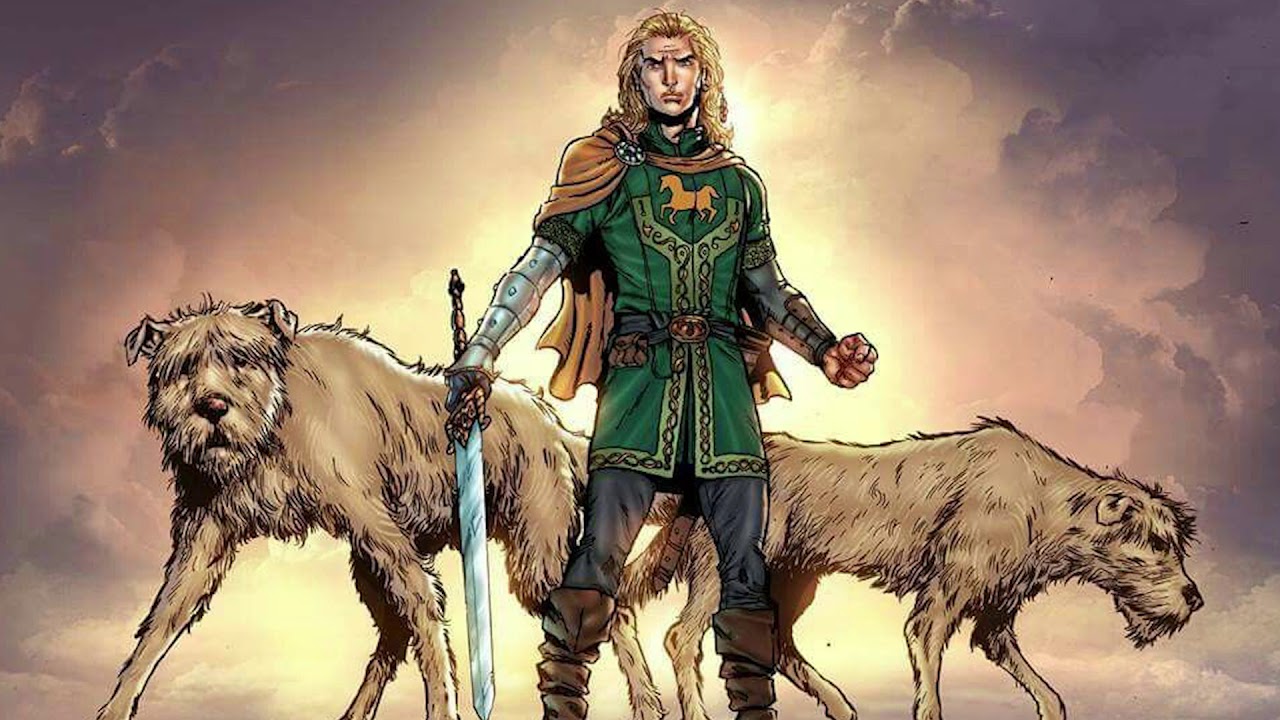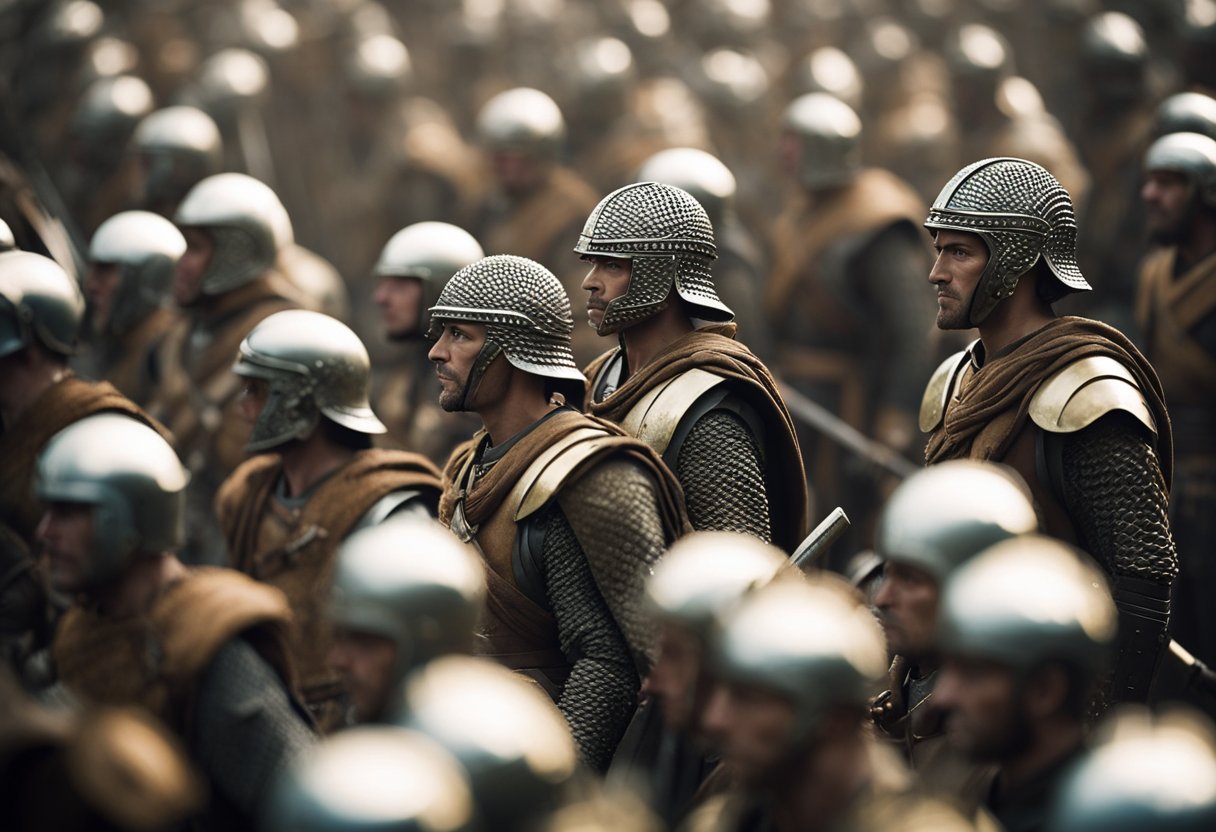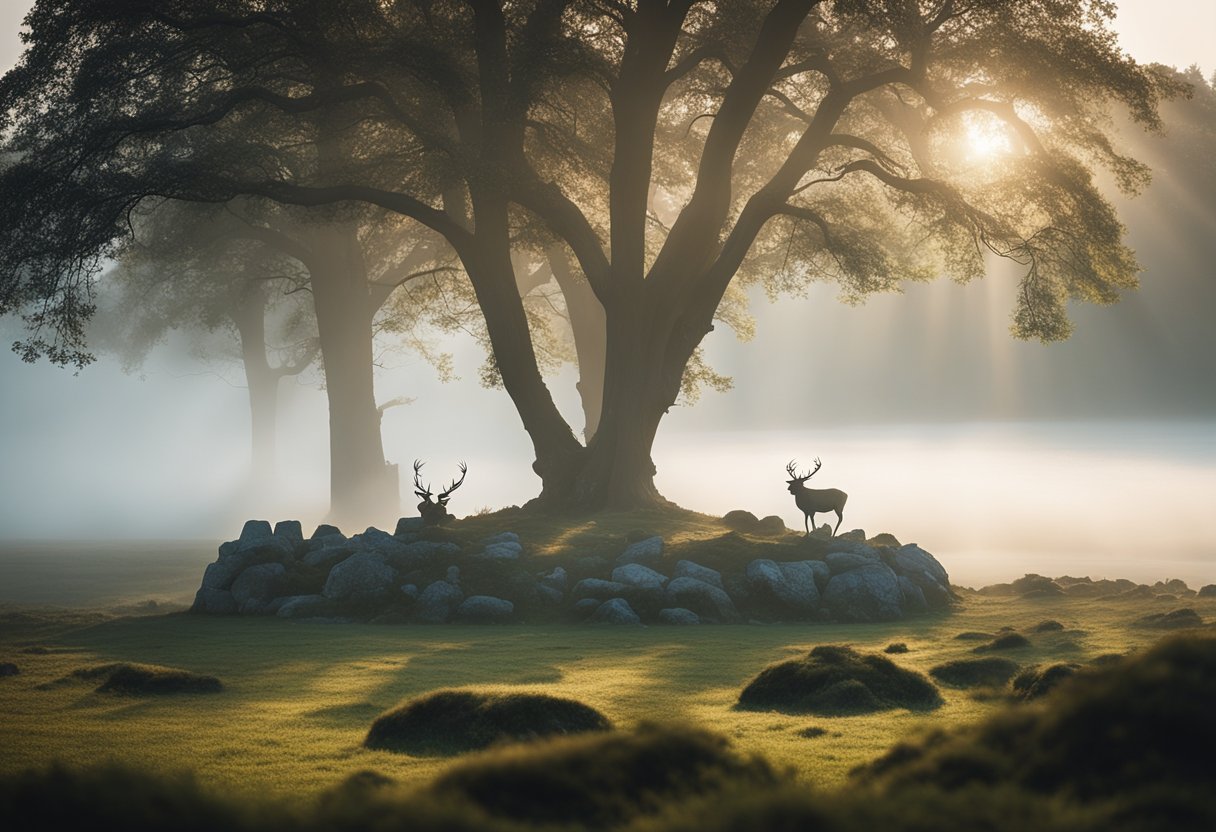Fionn mac Cumhaill: Unveiling the Legend’s Roots in History and Myth

Updated On: March 14, 2024 by Eman Sameh
The saga of Fionn mac Cumhaill straddles the realms of myth and history, intertwining them in a way that has captivated listeners and readers for generations. His tale is imbued with the rich tapestry of Irish culture and the oral tradition that has kept it alive through the ages. Fionn, the celebrated warrior, hunter, and leader of the Fianna, embodies the qualities of bravery, wisdom, and strength, making him a central figure in Irish folklore and a potent symbol of Irish cultural identity.

His narrative, which embraces his miraculous birth, extraordinary childhood, and the leadership of the legendary band of warriors known as the Fianna, weaves together a complex web of relationships, adventures, and supernatural elements. While his story is steeped in magical beings and mythical deeds, geographical locations and some historical elements within the tales suggest a grounding in reality. These aspects have led scholars and enthusiasts alike to explore the possibility that Fionn mac Cumhaill’s story, while mythologised, might have roots in the exploits of a real historical figure or figures emerging from the mists of Ireland’s ancient past.
Origins of the Legend
In our exploration of Irish mythology, one figure stands out: Fionn mac Cumhaill, also known as MacCool. His tales are woven into the fabric of Irish folklore, immortalised in the body of work known as the Fenian Cycle. We find his beginnings shrouded in the mists of myth and history, fascinating for their blend of supernatural elements and human exploits.
Fionn’s lineage is of notable importance; his father, Cumhaill, led the Fianna, a group of powerful warriors. It’s told that his mother, Muirne, was the daughter of a druid, imparting to the legend its connection to the mystical. Upon Cumhaill’s death, it fell to Muirne and the druidess Bodhmall to protect Fionn. Their care shielded him from enemies and imbued him with the knowledge necessary to survive and thrive.
The legend of Fionn grows with every retelling, his life becoming a captivating narrative of bravery, wisdom, and supernatural encounters. From the escape of his pregnant mother to his secretive upbringing by a druidess, these stories reflect the intersection of the natural and spiritual worlds intrinsic to Irish Mythology.
Our understanding of Fionn has been pieced together from ancient manuscripts, storytelling traditions, and archaeological evidence. While we must acknowledge the embellished nature of myths, they serve a critical function: preserving the ethos and values of ancient Irish society. Through Fionn’s tales, we grasp the era’s cultural emphasis on knowledge, leadership, and valour.
In delving into Fionn mac Cumhaill’s origins, we’re reminded of Ireland’s rich mythical tapestry—an essential component of a culture that continues to captivate us with its depth and complexity.
Fionn’s Early Life

Fionn mac Cumhaill’s early years were characterised by his noble heritage, secret upbringing, and remarkable education, which set the stage for his legendary status in Irish mythology.
Birth and Lineage
Born to Cumhal, the leader of the warrior band Fianna, and Muirne, the daughter of a renowned druid, Fionn mac Cumhaill inherited a proud lineage fraught with adversity. His father’s death prompted Muirne to entrust Fionn to the care of skilled protectors, ensuring his survival against those who sought to harm him.
Growth and Training
The wilderness became the classroom for Fionn mac Cumhaill. Under the guidance of the druidess Bodhmall and the warrior Liath Luachra, he learned the ways of the forest, the lore of the druids, and the arts of combat, all of which prepared him for his famous encounter with Finnegas and the mythical Salmon of Knowledge, an event that would mark his transition from boy to legend.
The Fianna and Their Deeds

In recounting the epic saga of the Fianna, we explore the prolific band of warriors central to the ancient Fenian Cycle. Their tales, woven into the fabric of Irish mythology, are marked by heroic battles and defining moments that still capture the imagination.
Formation
The Fianna were established as bands of elite warriors bound by strict codes of honour and conduct. Legendary figures such as Fionn mac Cumhaill arose amongst these ranks, leading the Fianna to prominence. The inception of the Fianna can notably be traced back to the Battle of Cnucha, where Cumhall, Fionn’s father, met his end, setting the stage for future legends.
Notable Battles
Throughout their existence, the Fianna engaged in numerous conflicts, their exploits immortalised within the tales of the Fenian Cycle. One significant warrior, Goll Mac Morna, clashed and eventually formed a volatile alliance with Fionn. Their deeds in battle are the embodiment of courage and strength, central to the narratives of the Fianna.
Decline and Dissolution
The Fianna’s twilight years saw their decline as internal rifts and external pressures mounted. Their dissolution, a result of treachery and the inexorable passage of time, marked the end of an era. Despite their disbandment, the Fianna’s legacy endures, their stories echoing through centuries as a testament to their indelible mark on Irish history and legend.
Major Figures in Fionn’s Story
In the rich tapestry of Irish mythology, a few key characters stand paramount in the narratives surrounding Fionn mac Cumhaill. These characters shaped Fionn’s life, forging alliances and rivalries that defined the legendary tales passed down through generations.
Allies and Kin
- Oisín: Oisín, portrayed as the illustrious son of Fionn mac Cumhaill, is credited with not only being a formidable warrior but also a revered poet. His tales often serve as a bridge between the mortal and Fey worlds, capturing the imagination of those who relish the world of Irish mythology.
- Oscar: Celebrated for his prowess, Oscar, the grandson of Fionn, is another central figure. Known for his valour, his destiny was deeply intertwined with the Fianna, the famed band of warriors led by Fionn.
- Gráinne: The beautiful and headstrong daughter of Cormac mac Airt, the High King of Ireland, Gráinne’s betrothal to Fionn leads to one of the most poignant love triangles in the mythology when she elopes with Diarmuid Ua Duibhne.
Rivals and Foes
- Goll Mac Morna: Once a formidable foe, Goll became an ally following a reconciliation with Fionn. His narrative arc from adversary to companion is a classic tale of rivalry transforming into respect.
- Diarmuid Ua Duibhne: Diarmuid’s life is a thrilling and tragic tale of love, betrayal and adventure. Though initially one of Fionn’s most trusted warriors, he ultimately becomes a central figure in the tales of pursuit and escapes with Gráinne.
- Tadg Mac Nuadat: As Gráinne’s father, Tadg plays a pivotal role in deriving Fionn’s legend. His influence stretches across the sagas as he positions himself both as family and as forebearer of fateful events through his daughter.
The sagas of Fionn are not only stories of adventures but also chronicles of relationships, intricate and entwined, that shape the destiny of their central hero. We see Fionn’s world as interlaced with loyalty and conflict, with each character carving their niche in the eternal legends of the Emerald Isle.
Notable Tales and Adventures
In the rich tapestry of Irish mythology, the sagas of Fionn mac Cumhaill stand as a testament to heroism and wonder. His life was marked by extraordinary events and profound encounters that continue to resonate in the cultural imagination of Ireland and beyond.
The Pursuit of Diarmuid and Gráinne
In one of the most poignantly romantic tales, the love triangle between Fionn, his warrior Diarmuid Ua Duibhne, and Gráinne—the daughter of Cormac Mac Airt—unfolds with dramatic consequences. Gráinne, betrothed to Fionn, falls deeply in love with Diarmuid during a feast at Tara, compelling her to invoke a love prophecy. The two lovers elope, igniting a relentless chase across Ireland as Fionn and his loyal band of Fianna warriors pursue them. Their journey is laced with enchantments and peril, showcasing the complexities of love and fidelity.
The Enchantments of Almu
Almu, now known as the Hill of Allen in County Kildare, was the fabled seat of Fionn mac Cumhaill, where he and the Fianna are said to have resided. The Hill of Almu was not merely a stronghold but also a place steeped in enchantment and prophecy. Legends tell of how the protective spells cast around Almu served as a sanctuary for Fionn and the Fianna, with magical barriers that could only be broken through an intricate knowledge of its secrets. The enchantments of Almu stand as symbols of the supernatural elements that so frequently intertwine with the lives of heroes in mythological narratives.
Fionn in Irish and Celtic Culture
In the tapestry of Irish and Celtic culture, Fionn mac Cumhaill is a mythic paragon whose adventures and valorous exploits resonate throughout literature and culture. He is a literary and cultural figure immortalised across various forms of expression.
Literary Significance
In Irish literature, Fionn mac Cumhaill is a prominent figure, particularly within the Fenian Cycle, one of the cornerstones of Irish mythology. His exploits and heroic deeds, passed down through generations, have been integral in shaping the nation’s storytelling heritage. James Stephens, an Irish novelist and poet, contributed to Fionn’s literary presence with his retelling of these myths in works like “The Boyhood of Fionn” and “The Birth of Bran”. Such texts not only entertain; they serve as cultural artefacts that offer insights into the societal values and the storied past of Ireland.
Morgan Llywelyn, an American-Irish author, has also significantly contributed to bringing Fionn’s stories to contemporary audiences. Her tomes breathe new life into age-old legends, blending historical fact with rich, imaginative fiction to reimagine Fionn mac Cumhaill for modern readers.
Cultural Representation
In popular culture, the legacy of Fionn mac Cumhaill continues to leave a vivid imprint. From television series to novels, his legend has been adapted and reimagined, underscoring its relevance and appeal across various entertainment media. This widespread recognition not only sustains interest in Celtic mythology but also gives Fionn mac Cumhaill an enduring presence in modern narratives.
To this day, Fionn’s character remains a sturdy pillar in Ireland’s cultural identity, bridging the gap between its past and present. He is celebrated in festivals and portrayed in art and serves as an emblem of Irish heroism and wisdom. Through such representations, the spirit of Fionn mac Cumhaill endures, a testament to the lasting influence of Irish heroes on the cultural landscape.
Mythical Elements and Magical Beings

In the rich tapestry of Irish mythology, Fionn mac Cumhaill’s legend is interwoven with extraordinary creatures and enchanted objects that shape his destiny. We’ll explore the creatures and realms that are integral to his tales, as well as the magical items that bolster his heroic status.
Creatures and the Otherworld
In our legends, the Otherworld is a realm that exists alongside our own, populated with beings both wondrous and fearsome. Fionn’s interactions with this mystical place often lead to encounters with magical creatures, some of which are said to offer wisdom or challenge his prowess. The Otherworld in Tales of Fionn is not just a backdrop but a pivotal element that drives the narrative forward, reflecting the intertwining of the human and the mystical.
Objects of Power
Fionn is associated with several artefacts of great might, imbuing his character with a sense of awe and reverence. Among these is the Magical Spear, a weapon of unparalleled strength that is as much a symbol of his leadership as it is a tool in battle. On the other hand, we find stories of the Thumb of Knowledge, which bestowed upon Fionn the wisdom of the ages when he inadvertently tasted the Salmon of Knowledge. Such objects in our tales are not mere tools but catalysts for transformation and enlightenment, marking the steps of Fionn’s journey from a warrior to a figure of legend.
These are but a few touches of the fantastical within the saga of Fionn mac Cumhaill. They reflect our love for stories where the mundane meets the magical, shaping the heroes and histories we cherish.
The Blending of History and Myth
In our exploration of Fionn mac Cumhaill, the lines between history and myth often blur, creating a rich tapestry that resonates deeply within Irish culture and beyond.
Historic Parallels
It is believed that Fionn mac Cumhaill, leader of the legendary Irish warriors known as the Fianna, may have roots in historical figures. Parallels drawn between Fionn’s narrative and real-world events suggest a possible blending of his mythic tale with Ireland’s distant past. Tara, once the seat of the High Kings of Ireland, features in tales of Fionn as a place of significance, solidifying its historical and legendary importance.
Cultural Evolution
Over time, the myth of Fionn mac Cumhaill has undergone cultural evolution, absorbing elements from various eras and reflecting historical changes within Irish society. Tales of Fionn by the Boyne or engaging in the activities of a typical Celtic Warrior exemplify the dynamic nature of these myths. They stretch and adapt, mirroring the endurance and transformation of our collective narrative.
Fionn’s Legacy and Modern Relevance
In our modern times, Fionn mac Cumhaill’s stature as a central figure of Irish Culture continues to resonate powerfully, entwining myth and history. His tales from the Fionn Cycle still capture the imagination, exemplifying timeless themes such as wisdom, courage, and leadership.
Fionn’s legacy extends beyond Ireland, touching on facets of Scottish lore too. The tale of Fionn as the Scottish Giant who built the Giant’s Causeway in Antrim to bridge the gap between Ireland and Scotland is a fine example. This legend portrays how his stories are deeply rooted in the geographical and cultural landscapes of both countries.
The Battle of Cath Gabhra is another significant reference that features in the Fenian Cycle tales, framing the historical twilight of the Fianna. The retelling of this battle often serves as a metaphor for the end of a golden age in Irish mythology, mirroring the transition of societies from old to new.
In contemporary settings, Fionn’s narratives are more than escapist tales; they form part of our cultural education. They underscore the importance of heritage in understanding who we are. Through education, literature, and tourism, Fionn remains an icon of cultural identity. He serves as a bridge from past to present, reminding us of the richness of Celtic traditions and offering us narratives to which we can still relate.
Our collective interest in Fionn’s exploits mirrors the dedication of platforms like Connolly Cove, which cherish the past while engaging with a global audience. Their commitment mirrors our own to carry Fionn’s legacy into the future, ensuring his stories continue to enchant generations worldwide.
Sites and Geography in Fionn’s Lore
In exploring the landscapes immortalised by Fionn mac Cumhaill’s escapades, we discover a tapestry of sites pivotal in his mythos. The River Boyne in Leinster, flowing through the Irish heartlands, is a significant geographical feature associated with Fionn’s stories. Here, the salmon of knowledge was caught, imparting its wisdom to Fionn.
Almu (Hill of Allen), Fionn’s reputed residence, is nestled in the verdurous plains of County Kildare. This hill fort is said to be where Fionn overlooked Leinster, the eastern province that involves a multitude of sites linked to his legend.
Ballyfin, within the same province, conceals within its landscape the echoes of Fionn’s lifetime. It is part of the fabric of the surroundings that our mythic hero roamed and protected.
Lastly, Sliabh Bladhma (Slieve Bloom Mountains) further embody the rugged terrain where Fionn’s tales of bravery unfolded. It’s said his warriors, the Fianna, trained amid these mountains’ serene and challenging environs.
| Location | Significance |
|---|---|
| River Boyne | Site of the Salmon of Knowledge capture |
| Hill of Allen | Fionn’s stronghold overlooking Leinster |
| Ballyfin | Intertwined with Fionn’s movements in Leinster |
| Slieve Bloom | Training ground for the Fianna |
Each place forms a piece of the intricate puzzle of Fionn’s lore. These locations not only ground his extraordinary deeds in our physical world but also enrich our understanding of Ireland’s mythological tapestry. We, as custodians of such tales, are reminded of the enduring connection between Irish history and the breathtaking landscapes that have borne witness to it.
Frequently Asked Questions
In this section, we address some of the most common inquiries concerning the celebrated figure of Fionn mac Cumhaill, drawing from the fabled narratives of Irish mythology and historical discussions.
Who are the main characters in the tales of Fionn mac Cumhaill?
The tales of Fionn mac Cumhaill involve a cast of central characters, including Fionn himself, his father Cumhall, his warrior band, the Fianna, and his various adversaries. Key figures also encompass his love interests and his son, Oisín.
What is the story behind the Salmon of Knowledge in relation to Fionn mac Cumhaill?
The Salmon of Knowledge is a pivotal tale in the mythos surrounding Fionn. After accidentally gaining the wisdom of the world by tasting the salmon’s juices, Fionn was endowed with unsurpassed knowledge and wisdom.
How is Fionn mac Cumhaill depicted in Irish mythology?
In Irish mythology, Fionn mac Cumhaill is portrayed as a formidable warrior, the leader of the roaming fighters known as the Fianna. His portrayal embodies the qualities of heroism, intelligence, and, often, a profound connection to the natural and supernatural worlds.
Is there historical evidence to suggest the existence of Fionn mac Cumhaill?
Debates persist regarding the historical evidence of Fionn mac Cumhaill, with some suggesting he may have been inspired by real figures or events, though no definitive evidence confirms his factual existence.
How is Fionn mac Cumhaill represented in modern media and fiction?
Fionn mac Cumhaill has manifested in modern media and fiction as a symbol of Irish identity, portrayed in books, films, and various arts, often exploring his mythological roots with a modern twist.
What is the correct pronunciation of Fionn mac Cumhaill?
The correct pronunciation of Fionn mac Cumhaill in English is /ˈfɪn mək ˈkuːl/. In the original Irish pronunciation, it is approximately /ˈfʲiːn̪ˠ mˠək ˈkʷʊlʲə/.






